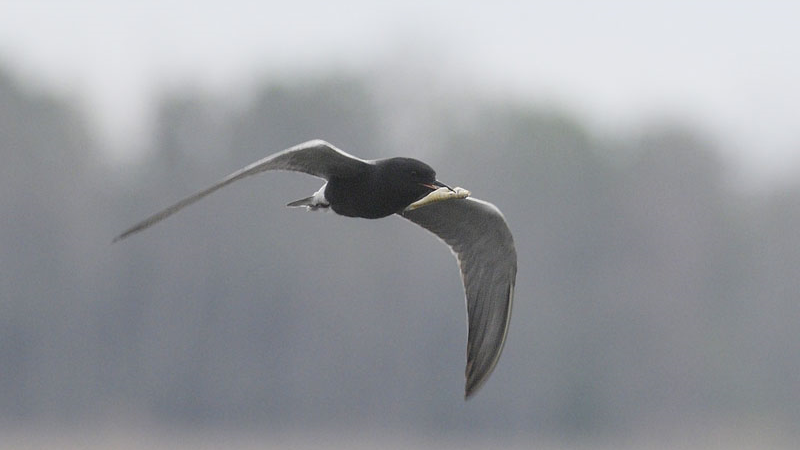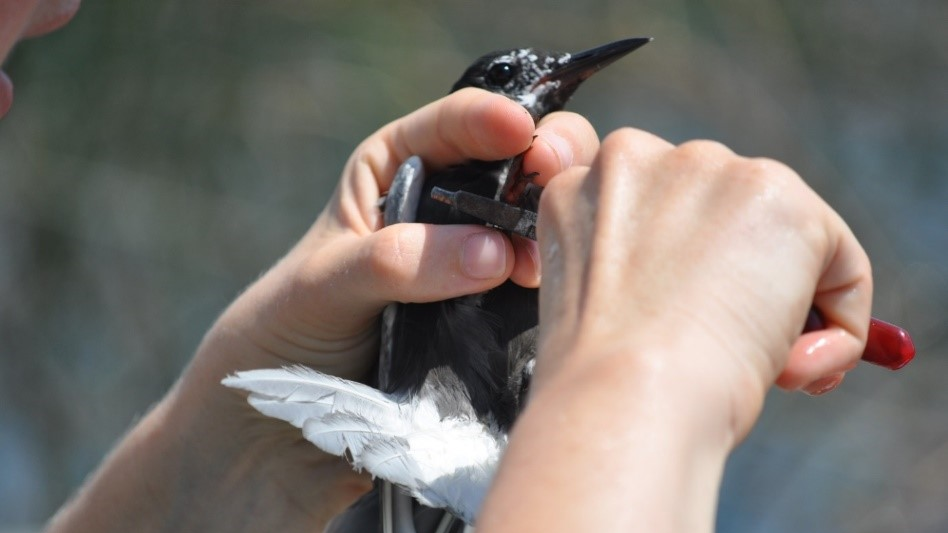
Great Lakes Moment is a monthly column written by Great Lakes Now Contributor John Hartig. Publishing the author’s views and assertions does not represent endorsement by Great Lakes Now or Detroit Public Television.
Who spends half their life flying across oceans?
Airplane pilots?
No, it’s black terns that spend half their lives between the coast of Central and South America and in U.S. and Canadian marshes, including the Great Lakes, where they create their nests on mats of vegetation that float in marshes.
In Michigan, black terns have declined by 70 percent since 1966, raising concern within the conservation community and compelling the Michigan Department of Natural Resources to designate them as a species of “special concern” from a conservation perspective.
Erin Rowan, the MI Birds program associate at Audubon Great Lakes, loves birds, including black terns, and she hopes others will experience a sense of wonder from them as part of nature’s beauty.
But Rowan also knows firsthand from her research that black terns, and indeed all birds, are important indicators of ecosystem health. They are the proverbial canary in the coal mine, telling us that that there is danger in our ecosystem or home where we live.

Erin Rowan banding a Black Tern chick, Photo courtesy of Detroit Audubon
After graduating from the University of California-Berkeley with a degree in conservation and resource studies, Rowan took a job with the Institute for Bird Populations coordinating bird-banding programs to better inform conservation of birds and their habitats. She then moved to Detroit to take a job with Detroit Audubon as their research coordinator where she specialized in black tern research and conservation in the St. Clair Flats. Her research has shown that high water levels, frequent storms and limited vegetation mats seem to decrease the nesting success of the black terns. Audubon is now experimenting with floating, human-made nesting platforms to help build the population.
From there Rowan joined the Audubon Great Lakes team as a MI Birds program associate. MI Birds is a public outreach and education program created by Audubon Great Lakes and the Michigan DNR to deepen Michiganders’ engagement in the understanding, care and stewardship of public lands that are important for birds and local communities. She is also continuing her black tern research as part of providing compelling citizen-science experiences.
Concern for bird loss catapulted across North America last year when Audubon published a report titled “Survival by Degrees: 389 Bird Species on the Brink.” The report showed the vulnerability of birds across North America to climate change. The report’s analysis leveraged big data and incorporated the unique biology of each bird to determine its vulnerability.

Black Tern, Photo courtesy of Jerry Jourdan
“Survival By Degrees” found that 64 percent of species (389 of 604) across breeding and non-breeding seasons were moderately or highly vulnerable to climate change. Nearly two-thirds (63 percent, or 383 of 604) of all species across both breeding and non-breeding seasons were classified as vulnerable under a 3.0 degrees Celsius global mean temperature rise, compared to 54 percent at 2.0°C (327 of 604) and 47 percent at 1.5°C (286 of 604). That means nearly two-thirds of America’s birds are at risk if the current pace of global warming continues.
As an indicator species, birds are telling us the time to act is now.
The National Audubon Society has shown us that as global temperatures rise weather patterns shift and vital habitats disappear. Global warming changes the distribution of plants and other animals that birds need for nesting, protection and food. This means birds are running out of places to live and things to eat in their current habitats. In addition, increasingly extreme weather events, another effect correlated with rising average temperatures, can wipe out entire bird colonies.

Black Tern banding , Photo courtesy of Diane Cheklich
The study also found that climate change mitigation efforts that can stabilize mean global temperature rise at 1.5 degrees Celsius, compared to 3.0 degrees Celsius, would lead to the greatest reduction in the number of species vulnerable in the breeding season. Furthermore, mitigation would most benefit birds in urban/suburban habitats (38 percent reduction in vulnerability), followed by the boreal forests (23 percent reduction), grasslands (23 percent reduction), eastern forests (20 percent reduction) and generalists (17 percent reduction).
Today, Rowan is working at the grassroots level to educate people about the fact that birds and humans live in the same ecosystem and what we do to our ecosystem we do to ourselves.
Birds are telling us that our local ecosystems or life support systems are under stress. But there are things we all can do:
- We can promote and practice energy conservation.
- We can use and support renewable energy.
- We can ask our elected officials to create a safe and resilient community.
- We can encourage our cities to become signatories of the Chicago Climate Charter, like Detroit, to address climate change head on and cooperate to reduce carbon emissions.
- We can encourage our elected officials to pass meaningful state and federal legislation leading to economy-wide solutions and 100 percent clean energy.
- We can encourage Detroit Metropolitan communities to declare a climate emergency, similar to what Windsor, Ontario, has done.
- We can encourage decision-makers to act swiftly to become carbon neutral by 2050, hold the temperature rise to less than 1.5 degrees Celsius, and help protect the 64 percent of bird species at risk of extinction.
- We can support implementation of Detroit’s Sustainability Action Agenda.
- We can support implementation of the Detroit Climate Action Plan.
- We can all do our part and listen to the birds — they know.
For more information visit: Survival by Degrees: 389 Bird Species on the Brink
Great Lakes Now Contributor John Hartig is a board member at the Detroit Riverfront Conservancy. He serves as the Great Lakes Science-Policy Advisor for the International Association for Great Lakes Research and has written numerous books and publications on the environment and the Great Lakes. Hartig also helped create the Detroit River International Refuge, where he worked as the refuge manager until his retirement.
Featured Image: Black Tern, Photo courtesy of Jerry Jourdan




